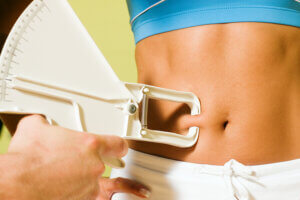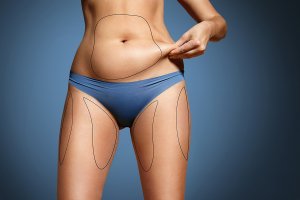The Physiology of Fat Loss

Fat is one of the three essential macronutrients that give structure and energy to the human body, along with proteins and carbohydrates. However, it can also be counterproductive when too much fat accumulates in the body. In this article, we’re going to have a look at the physiology of fat accumulation and fat loss.
When fat isn’t used to obtain energy, it accumulates in the fatty tissue reserves, what we commonly call ‘body fat’. One of the main objectives of physical exercise and being fit is getting a healthy body, free of excess fat. What happens behind the scenes? How does your body accumulate and lose fat?
The accumulation of fat
We’d just like to clear something up first. Not all of the fat that exists in your body’s fatty tissue reserves comes from the fat you consume in your daily diet. Of course, if you consume more calories on a certain day than what you burn, this calorie excess will be used to make fat (and sometimes to make muscle too).
This happens because of the way your body processes excess fats, proteins, and carbohydrates. If any of these substances are not used to generate energy, they’re converted into those yellowish compounds that make up fatty tissue through a process called esterification.
So, what makes a person fat, or what causes your body to accumulate excess fat? It’s consuming an excess or surplus of calories in your diet over a long period of time.
Fat loss
The reverse process happens when you create a calorie deficit. This energy deficit makes the body get the needed energy from the oxidization of fatty acids. The body gets these fatty acids by breaking down the triglycerides (a type of fat cell) that make up the fat reserves.

Oxidization of fatty acids
This process starts when your body recognizes that it needs energy. In the first place, it starts burning glycogen from the muscles and liver. This is because your body (and especially your brain) prefers to use glucose as fuel before resorting to alternative energy sources.
When your body has used up all the glycogen, it starts to consume those triglycerides we mentioned above. These small fat cells are inside the adipocytes, the cells that make up the body’s fat reserves. They go to the liver via the bloodstream and break down into three fatty acid molecules.
Lastly, these fatty acids break down into even smaller molecules that the body uses in the Krebs cycle or citric acid cycle. By means of this cycle, the body obtains energy in the form of ATPs (an energy-carrying molecule).
Fat loss during exercise
The whole fat loss process we described above happens at a faster rate during exercise. Low-intensity aerobic exercise especially uses stored fat as the main fuel source, while high-intensity anaerobic exercise uses other sources.
When you start to exercise, your body needs to send a lot more oxygen and nutrients to the muscles. That way, your body can meet the higher energy demand while you’re moving faster. This is why your heart rate and respiratory capacity increase with exercise, among other things.
During aerobic exercise, you use oxygen to give energy to the muscles, and this energy essentially comes from stored fat. Large quantities of triglycerides start to circulate and go to the liver and to the muscle tissue. And, as we explained earlier, they break down into smaller substances that can meet the body’s energy demand.

The best way to lose fat
When you understand these concepts, you can create a suitable plan for the loss of body fat. A good diet plan can help you to improve your appearance as well as your health. The key to fat loss is to create a calorie deficit that you can maintain over time.
With this deficit, the body will be continuously extracting triglycerides from the fatty cells and these will gradually shrink further and further. However, don’t forget that we’re talking about microscopic substances here. That means that for any changes to become visible, it will take time, and of course, patience.
Fat is one of the three essential macronutrients that give structure and energy to the human body, along with proteins and carbohydrates. However, it can also be counterproductive when too much fat accumulates in the body. In this article, we’re going to have a look at the physiology of fat accumulation and fat loss.
When fat isn’t used to obtain energy, it accumulates in the fatty tissue reserves, what we commonly call ‘body fat’. One of the main objectives of physical exercise and being fit is getting a healthy body, free of excess fat. What happens behind the scenes? How does your body accumulate and lose fat?
The accumulation of fat
We’d just like to clear something up first. Not all of the fat that exists in your body’s fatty tissue reserves comes from the fat you consume in your daily diet. Of course, if you consume more calories on a certain day than what you burn, this calorie excess will be used to make fat (and sometimes to make muscle too).
This happens because of the way your body processes excess fats, proteins, and carbohydrates. If any of these substances are not used to generate energy, they’re converted into those yellowish compounds that make up fatty tissue through a process called esterification.
So, what makes a person fat, or what causes your body to accumulate excess fat? It’s consuming an excess or surplus of calories in your diet over a long period of time.
Fat loss
The reverse process happens when you create a calorie deficit. This energy deficit makes the body get the needed energy from the oxidization of fatty acids. The body gets these fatty acids by breaking down the triglycerides (a type of fat cell) that make up the fat reserves.

Oxidization of fatty acids
This process starts when your body recognizes that it needs energy. In the first place, it starts burning glycogen from the muscles and liver. This is because your body (and especially your brain) prefers to use glucose as fuel before resorting to alternative energy sources.
When your body has used up all the glycogen, it starts to consume those triglycerides we mentioned above. These small fat cells are inside the adipocytes, the cells that make up the body’s fat reserves. They go to the liver via the bloodstream and break down into three fatty acid molecules.
Lastly, these fatty acids break down into even smaller molecules that the body uses in the Krebs cycle or citric acid cycle. By means of this cycle, the body obtains energy in the form of ATPs (an energy-carrying molecule).
Fat loss during exercise
The whole fat loss process we described above happens at a faster rate during exercise. Low-intensity aerobic exercise especially uses stored fat as the main fuel source, while high-intensity anaerobic exercise uses other sources.
When you start to exercise, your body needs to send a lot more oxygen and nutrients to the muscles. That way, your body can meet the higher energy demand while you’re moving faster. This is why your heart rate and respiratory capacity increase with exercise, among other things.
During aerobic exercise, you use oxygen to give energy to the muscles, and this energy essentially comes from stored fat. Large quantities of triglycerides start to circulate and go to the liver and to the muscle tissue. And, as we explained earlier, they break down into smaller substances that can meet the body’s energy demand.

The best way to lose fat
When you understand these concepts, you can create a suitable plan for the loss of body fat. A good diet plan can help you to improve your appearance as well as your health. The key to fat loss is to create a calorie deficit that you can maintain over time.
With this deficit, the body will be continuously extracting triglycerides from the fatty cells and these will gradually shrink further and further. However, don’t forget that we’re talking about microscopic substances here. That means that for any changes to become visible, it will take time, and of course, patience.
All cited sources were thoroughly reviewed by our team to ensure their quality, reliability, currency, and validity. The bibliography of this article was considered reliable and of academic or scientific accuracy.
- Strasser, B., Spreitzer, A., & Haber, P. (2007). Fat Loss Depends on Energy Deficit Only, Independently of the Method for Weight Loss. Annals of Nutrition and Metabolism, 51(5), 428–432. https://doi.org/10.1159/000111162
- Carey, D. G. (2009). Quantifying Differences in the “Fat Burning” Zone and the Aerobic Zone: Implications For Training. Journal of Strength and Conditioning Research, 23(7), 2090–2095. https://doi.org/10.1519/JSC.0b013e3181bac5c5
- Kuo, C.-H., & Harris, M. B. (2016). Abdominal fat reducing outcome of exercise training: fat burning or hydrocarbon source redistribution? Canadian Journal of Physiology and Pharmacology, 94(7), 695–698. https://doi.org/10.1139/cjpp-2015-0425
- McCarty, M. F. (1995). Optimizing exercise for fat loss. Medical Hypotheses, 44(5), 325–330. Retrieved from http://www.ncbi.nlm.nih.gov/pubmed/8583962
This text is provided for informational purposes only and does not replace consultation with a professional. If in doubt, consult your specialist.








